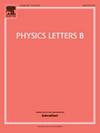Double ϕ production in p¯p reactions near threshold
IF 4.3
2区 物理与天体物理
Q1 ASTRONOMY & ASTROPHYSICS
引用次数: 0
Abstract
We employ an effective Lagrangian approach to investigate double ϕ production in the reaction near the threshold and describe a notable violation of the Okubo-Zweig-Iizuka (OZI) rule in this reaction process through hadronic degrees of freedom, using the currently available theoretical and experimental information. The ground-state nucleon and its s-wave resonances, i.e., , are taken into account in the t- and u-channel tree-level diagrams. The pentaquark-like nucleon resonance is also considered. In the s-channel diagrams, scalar and tensor mesons are incorporated, specifically and , respectively, along with the pseudoscalar meson . Our calculations suggest that contributions from the N and resonances significantly enhance the cross-section near the threshold. At the same time, those from the and mesons produce distinctive peak structures around GeV, qualitatively reproducing the JETSET experimental data. The openings of the and channels lead to the cusp structures, which can explain the nontrivial structures in the cross-section at and observed in the data. It turns out that contributions from the η and resonances are almost negligible. Additionally, polarization observables such as the spin density matrix element (SDME) provide crucial insights into the individual hadronic processes involved in this reaction.
在阈值附近的p¯p反应中产生双φ
我们采用有效的拉格朗日方法来研究阈值附近p¯p反应中的双φ产生,并通过强子自由度描述该反应过程中使用当前可用的理论和实验信息明显违反Okubo-Zweig-Iizuka (OZI)规则。基态核子及其s波共振,即N(1535,1650,1895),在t通道和u通道树级图中被考虑在内。五夸克类核子共振Ps(2071,3/2−)也被考虑。在s通道图中,包含了标量介子和张量介子,分别是f0(2020,2100,2200)和f2(1950,2010,2150),以及伪标量介子η(2225)。我们的计算表明,N和N共振的贡献显著增强了阈值附近的截面。同时,f0和f2介子在W=2.2 GeV附近产生了独特的峰结构,定性地再现了JETSET实验数据。Λ¯Λ和Σ¯Σ通道的开口导致尖点结构,这可以解释数据中观察到的W≈2MΛ和2MΣ截面上的非平凡结构。结果表明,η和Ps共振的贡献几乎可以忽略不计。此外,极化观测值,如自旋密度矩阵元素(SDME),为该反应中涉及的单个强子过程提供了重要的见解。
本文章由计算机程序翻译,如有差异,请以英文原文为准。
求助全文
约1分钟内获得全文
求助全文
来源期刊

Physics Letters B
物理-物理:综合
CiteScore
9.10
自引率
6.80%
发文量
647
审稿时长
3 months
期刊介绍:
Physics Letters B ensures the rapid publication of important new results in particle physics, nuclear physics and cosmology. Specialized editors are responsible for contributions in experimental nuclear physics, theoretical nuclear physics, experimental high-energy physics, theoretical high-energy physics, and astrophysics.
 求助内容:
求助内容: 应助结果提醒方式:
应助结果提醒方式:


